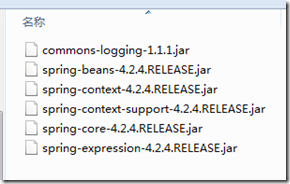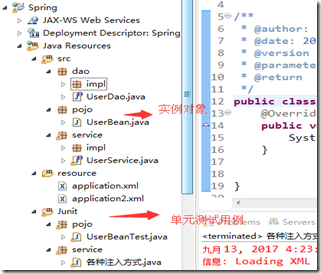简单来说就是减少层与层之间的耦合关系,本来在service调用dao要new,有了这个就可以通过注入的方式,相当与把所有的new操作都变成了在配置文件中配置,有改动时直接改配置就行了不用一个个java文件去改。
1.搭建web项目,导入spring核心包。copy到web目录lib即可。
项目的构成:
1.首先是创建一个bean。省略setter、getter
public class UserBean{
private String userName;
private int age;
private Date birthday;
private double salary;
}
建立spring的配置文件application.xml
<?xml version="1.0" encoding="UTF-8"?> <beans xmlns="http://www.springframework.org/schema/beans" xmlns:xsi="http://www.w3.org/2001/XMLSchema-instance" xmlns:p="http://www.springframework.org/schema/p" xmlns:context="http://www.springframework.org/schema/context" xmlns:aop="http://www.springframework.org/schema/aop" xmlns:tx="http://www.springframework.org/schema/tx" xsi:schemaLocation="http://www.springframework.org/schema/beans http://www.springframework.org/schema/beans/spring-beans.xsd http://www.springframework.org/schema/context http://www.springframework.org/schema/context/spring-context.xsd http://www.springframework.org/schema/aop http://www.springframework.org/schema/aop/spring-aop.xsd http://www.springframework.org/schema/tx http://www.springframework.org/schema/tx/spring-tx.xsd"> <import resource="application2.xml"/> <bean id="UserBean" class="pojo.UserBean" scope="singleton" lazy-init="true"> <!-- singleton – 单例模式 ,即整个应用只有一个实例 。适合于服务 bean 和Dao Bean。单例模式的对象实例在容器启动时候就会创建。 Prototype – 原型模式,即每次请求都创建一个对象。适合于action bean。原型模式的对象在请求对象时候创建 lazy-init - 懒加载,默认=false,启动就创建(不懒),true就是懒加载 --> <property name="userName" value="zs"></property> <property name="age" value="18"></property> <property name="birthday"> <bean class="java.util.Date"></bean> </property> <property name="salary" value="9000.33"></property> </bean> </beans>
单元测试,通过配置文件获得创建的对象。两种方式获得。都能打印出结果。
public class UserBeanTest { @Test public void test() { //启动spring 容器,指定配置文件。 ApplicationContext ctx=new ClassPathXmlApplicationContext("application.xml"); //通过容器获取UserBean对象 UserBean bean=(UserBean) ctx.getBean("UserBean"); System.out.println(bean.toString()); } @Test public void testByFactory(){ //通过工厂类得到bean对象 Resource resource= new ClassPathResource("application.xml"); BeanFactory factory=new XmlBeanFactory(resource); //通过容器获取UserBean对象 UserBean bean=(UserBean) factory.getBean("UserBean"); System.out.println(bean.toString()); } }
结果:
UserBean [userName=zs, age=18, birthday=Wed Sep 13 16:37:20 CST 2017, salary=9000.33]
2.对象的注入。
新建dao和impl
public interface UserDao { public abstract void print(); } ---------------------------------------------------------------------------------------- public class UserDaoImpl implements UserDao { @Override public void print() { System.out.println("dao打印:"); } }
新建service和impl
public interface UserService { public abstract void print(); } ------------------------------------------------------------------------------------------- public class UserServiceImpl implements UserService { //要注入它 UserDao dao; @Override public void print() { dao.print(); } public UserDao getDao() { return dao; } public void setDao(UserDao dao) { this.dao = dao; } }
建立配置文件2号
<?xml version="1.0" encoding="UTF-8"?> <beans xmlns="http://www.springframework.org/schema/beans" xmlns:xsi="http://www.w3.org/2001/XMLSchema-instance" xmlns:p="http://www.springframework.org/schema/p" xmlns:context="http://www.springframework.org/schema/context" xmlns:aop="http://www.springframework.org/schema/aop" xmlns:tx="http://www.springframework.org/schema/tx" xsi:schemaLocation="http://www.springframework.org/schema/beans http://www.springframework.org/schema/beans/spring-beans.xsd http://www.springframework.org/schema/context http://www.springframework.org/schema/context/spring-context.xsd http://www.springframework.org/schema/aop http://www.springframework.org/schema/aop/spring-aop.xsd http://www.springframework.org/schema/tx http://www.springframework.org/schema/tx/spring-tx.xsd"> <!-- set注入:对应在服务层调用dao给它setter、getter --> <bean id="dao" class="dao.impl.UserDaoImpl"></bean> <bean id="service" class="service.impl.UserServiceImpl"> <property name="dao" ref="dao"></property> </bean> <!-- 内部bean方式,也要setter、getter --> <bean id="service2" class="service.impl.UserServiceImpl"> <property name="dao"> <bean class="dao.impl.UserDaoImpl"></bean> </property> </bean> <!--P:命名空间注入属性值 也要setter、getter,跟set注入一样的,就是减少了property的数量。p:dao-ref="dao" 中的'dao'换为对应的注入对象即可--> <bean id="service3" class="service.impl.UserServiceImpl" p:dao-ref="dao"></bean> <!--自动注入(autowire) --> <bean id="service4" class="service.impl.UserServiceImpl" autowire="byName"></bean> <!--Aotowire=byType:根据名称属性类型自动进行注入。 --> <bean id="service5" class="service.impl.UserServiceImpl" autowire="byType"></bean> </beans>
在原来的配置文件中加上import把两个连接起来。
<import resource="application2.xml"/>
单元测试。
public class 各种注入方式 { @Test public void test() { //set注入 /** application.xml 要import */ ApplicationContext applicationContext=new ClassPathXmlApplicationContext("application.xml"); /** 合并的写法 */ // ApplicationContext applicationContext=new ClassPathXmlApplicationContext(new String[]{"application.xml","application2.xml"}); UserService service= (UserService) applicationContext.getBean("service"); service.print(); } @Test public void test2() { //内部bean ApplicationContext applicationContext=new ClassPathXmlApplicationContext("application.xml"); UserService service= (UserService) applicationContext.getBean("service2"); service.print(); } @Test public void test3() { //命名空间注入 ApplicationContext applicationContext=new ClassPathXmlApplicationContext("application.xml"); UserService service= (UserService) applicationContext.getBean("service3"); service.print(); } @Test public void test4() { //按照名字自动注入 ApplicationContext applicationContext=new ClassPathXmlApplicationContext("application.xml"); UserService service= (UserService) applicationContext.getBean("service4"); service.print(); } @Test public void test5() { //按照类型自动注入 ApplicationContext applicationContext=new ClassPathXmlApplicationContext("application.xml"); UserService service= (UserService) applicationContext.getBean("service5"); service.print(); } @Test public void test6() { //获取bean的另一个写法,会自动在配置文件中找对应的class类型匹配,但是配置文件里面自能有一个对应的类,多了也错 ApplicationContext applicationContext=new ClassPathXmlApplicationContext("application.xml"); UserService service= (UserService) applicationContext.getBean(UserService.class); service.print(); } }
test6这种获取bean的方式要只有一个才可以,很多个bean都是一样的,仅仅是id不同会报错的。
3.注解方式。























 7252
7252











 被折叠的 条评论
为什么被折叠?
被折叠的 条评论
为什么被折叠?








